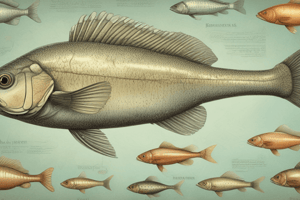Podcast
Questions and Answers
What is the primary role of vascular plants in contrast to bryophytes in terms of resource transport?
What is the primary role of vascular plants in contrast to bryophytes in terms of resource transport?
- Vascular plants utilize advanced xylem and phloem systems for transport. (correct)
- Vascular plants do not need any specialized systems for nutrient transport.
- Vascular plants depend solely on atmospheric moisture for survival.
- Vascular plants rely entirely on osmosis for hydration.
Which of the following is NOT a role played by bryophytes in ecosystems?
Which of the following is NOT a role played by bryophytes in ecosystems?
- Soil formation and stabilization
- Providing habitats for large mammals (correct)
- Serving as a food source for animals
- Indicating environmental changes
What adaptation allows bryophytes to thrive in moist environments?
What adaptation allows bryophytes to thrive in moist environments?
- Specialized surface structures for water absorption (correct)
- Large size and extensive root systems
- Vascular tissues for rapid water transport
- Dependence on dry conditions for reproduction
What is the primary goal of taxonomy?
What is the primary goal of taxonomy?
Which phase of the bryophyte life cycle is responsible for producing spores?
Which phase of the bryophyte life cycle is responsible for producing spores?
Which of the following is not a level in the Linnaean classification system?
Which of the following is not a level in the Linnaean classification system?
Which of the following statements about bryophytes and traditional medicine is accurate?
Which of the following statements about bryophytes and traditional medicine is accurate?
Which characteristic is shared by all bryophytes?
Which characteristic is shared by all bryophytes?
Which of the following best describes the Linnaean system?
Which of the following best describes the Linnaean system?
How do bryophytes primarily absorb water?
How do bryophytes primarily absorb water?
Which phyla is characterized by having horn-shaped sporophytes?
Which phyla is characterized by having horn-shaped sporophytes?
What limits the size and distribution of bryophytes?
What limits the size and distribution of bryophytes?
What role do bryophytes play in terrestrial ecosystems?
What role do bryophytes play in terrestrial ecosystems?
Flashcards
Taxonomy
Taxonomy
The scientific study of classifying organisms into hierarchical groups based on shared characteristics and evolutionary relationships.
Hierarchical System
Hierarchical System
A system of classification where organisms are grouped into increasingly specific categories, with broader groups encompassing narrower ones.
Evolutionary Relationships
Evolutionary Relationships
The connections between organisms based on their shared ancestry, reflected in similar characteristics.
Binomial Nomenclature
Binomial Nomenclature
Signup and view all the flashcards
Bryophytes
Bryophytes
Signup and view all the flashcards
Vascular Tissues
Vascular Tissues
Signup and view all the flashcards
Hepatophyta (Liverworts)
Hepatophyta (Liverworts)
Signup and view all the flashcards
Anthocerophyta (Hornworts)
Anthocerophyta (Hornworts)
Signup and view all the flashcards
Vascular Plants
Vascular Plants
Signup and view all the flashcards
Bryophyte Importance
Bryophyte Importance
Signup and view all the flashcards
Adaptations for Moist Environments
Adaptations for Moist Environments
Signup and view all the flashcards
Gemmae
Gemmae
Signup and view all the flashcards
Study Notes
Introduction to Taxonomy
- Taxonomy is the science of classifying organisms.
- It uses a hierarchical system, arranging organisms into increasingly specific groups.
- The primary goal of taxonomy is to organize knowledge about organisms in a way that reflects their evolutionary relationships.
- This involves creating a standardized system for naming and classifying organisms.
- This allows scientists to communicate and share information about the diversity of life effectively.
Basic Principles of Biological Classification
- Organisms are grouped based on shared characteristics, both physical and genetic.
- These characteristics reflect evolutionary relationships (phylogeny).
- The more characteristics shared, the more closely related the organisms are considered to be.
- This classification is hierarchical, with broader, more inclusive groups, nested within successively narrower groups.
The Linnaean System
- Developed by Carl Linnaeus, the Linnaean system is a widely accepted system of biological classification.
- It uses a hierarchical structure based on the following levels: Domain, Kingdom, Phylum, Class, Order, Family, Genus, Species.
- This system has been pivotal in the field of taxonomy, though modern advancements in molecular biology have modified some aspects.
- The naming of organisms is binomial, using the genus and species names.
Bryophytes (Non-vascular Plants)
- Bryophytes represent a large group of plants characterized by their lack of vascular tissues (xylem and phloem).
- They are non-flowering plants.
- Bryophytes are typically small and herbaceous, often found in moist environments.
- This leads to diverse adaptations for water absorption and transport.
- They represent an important component of terrestrial ecosystems, serving as indicators of environmental conditions and providing habitat for other organisms.
Key Phyla in Bryophytes
- Hepatophyta (Liverworts): Often characterized by their lobed or leaf-like structures.
- Anthocerophyta (Hornworts): Distinguished by their unique horn-shaped sporophytes.
- Bryophyta (Mosses): Composed of leafy shoots, often forming dense mats or cushions, and featuring specialized water-conducting cells.
Differences from Vascular Plants
- Bryophytes lack specialized vascular tissues for transporting water and nutrients throughout the plant.
- This limits their size and distribution to moist habitats.
- In comparison, vascular plants have efficient systems for water and nutrient transport, allowing them to thrive in a wide range of environments.
- Bryophytes rely on osmosis and water conduction through cells for their hydration, whereas vascular plants have advanced xylem and phloem systems for water and nutrient movement.
Importance of Bryophytes
- Bryophytes play crucial roles in ecosystems.
- They contribute to soil formation and stabilization.
- They serve as a food source for various animals.
- Some are used in traditional medicine.
- They are sensitive to environmental changes and are considered good bioindicators of air and water pollution.
- They are vital for maintaining biodiversity in terrestrial ecosystems.
Adaptations for Moist Environments
- Bryophytes have adaptations like specialized surface structures for water absorption.
- Their small size and a lack of vascular tissue make them dependent on their surrounding environment.
- Their life cycle integrates both sexual and asexual reproduction.
- They often have elaborate mechanisms for water retention and uptake.
- These adaptations are key to their survival in moist habitats.
Reproduction Method
- Bryophytes reproduce both sexually and asexually.
- Sexual reproduction often involves the production of spores.
- Sporophyte is the spore-producing phase of the life cycle that relies on the gametophyte for nutrients.
- Asexual reproduction usually involves fragmentation or the production of gemmae.
- Gemmae is a type of asexual reproduction often seen in liverworts.
Studying That Suits You
Use AI to generate personalized quizzes and flashcards to suit your learning preferences.




